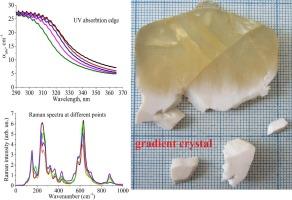Features of the defect structure of a lithium-gradient nonlinear optical single crystal LiNbO3 and their manifestation in the Raman spectra
IF 4.3
2区 化学
Q1 SPECTROSCOPY
Spectrochimica Acta Part A: Molecular and Biomolecular Spectroscopy
Pub Date : 2024-10-28
DOI:10.1016/j.saa.2024.125340
引用次数: 0
Abstract
LiNbO3 crystal with a lithium composition gradient of Li/Nb = 0.8 wt%/cm (Li0.97..1.01Nb1.03..0.99O3) were obtained. A monotonic change in the edge of the UV absorption edge is observed when scanning the surface of the gradient crystal along the growth direction. Raman spectra from different areas of studied crystal were analyzed in a wide frequency range, which includes the region of fundamental vibrations of the crystal lattice (100–900 cm−1) and the region of overtone processes (900–3000 cm−1). A compositionally homogeneous, congruent LiNbO3 crystal was used as a comparison sample. It was found that in the spectra obtained from different parts of the gradient crystal, there is a significant scatter in the frequency values of the lines corresponding to the fundamental vibrations of the crystal lattice, but at the same time, the number of lines corresponding to the fundamental vibrations of the lattice for the gradient and compositionally homogeneous LiNbO3 crystals is the same. Moreover, in the spectrum of a gradient crystal in the region of overtone processes of fundamental vibrations, significantly more lines (35 lines) are observed than in the spectrum of compositionally homogeneous crystals (15 lines). The data obtained show that the state of the defect structure of compositionally homogeneous crystals and gradient LiNbO3 crystal is significantly different. The discovered differences between the defective structure of a gradient crystal and the defective structure of a compositionally homogeneous crystal may be the reason for compensation (damping) of distortions during nonlinear optical conversion of laser radiation by a gradient crystal due to the uneven temperature distribution along the length of the crystal. In compositionally homogeneous crystals, such temperature distortions significantly limit the efficiency of nonlinear optical conversion.

锂梯度非线性光学单晶 LiNbO3 的缺陷结构特征及其在拉曼光谱中的体现
获得了锂成分梯度为 Li/Nb = 0.8 wt%/cm 的 LiNbO3 晶体(Li0.97...1.01Nb1.03...0.99O3)。沿晶体生长方向扫描梯度晶体表面时,可观察到紫外吸收边缘的单调变化。对所研究晶体不同区域的拉曼光谱进行了宽频率范围的分析,其中包括晶格基振区域(100-900 cm-1)和泛音过程区域(900-3000 cm-1)。以成分均匀、全等的 LiNbO3 晶体作为对比样品。研究发现,在从梯度晶体的不同部分获得的光谱中,对应于晶格基振的谱线的频率值有明显的分散,但同时,梯度晶体和成分均一的铌酸锂晶体对应于晶格基振的谱线数量是相同的。此外,在基振泛音过程区域的梯度晶体光谱中,观察到的谱线(35 条)明显多于成分均一晶体的光谱(15 条)。所获得的数据表明,成分均一晶体和梯度氧化铌锂晶体的缺陷结构状态明显不同。梯度晶体的缺陷结构与成分均质晶体的缺陷结构之间的差异可能是梯度晶体在对激光辐射进行非线性光学转换时,由于沿晶体长度方向的温度分布不均匀而产生畸变补偿(阻尼)的原因。在成分均匀的晶体中,这种温度畸变极大地限制了非线性光学转换的效率。
本文章由计算机程序翻译,如有差异,请以英文原文为准。
求助全文
约1分钟内获得全文
求助全文
来源期刊
CiteScore
8.40
自引率
11.40%
发文量
1364
审稿时长
40 days
期刊介绍:
Spectrochimica Acta, Part A: Molecular and Biomolecular Spectroscopy (SAA) is an interdisciplinary journal which spans from basic to applied aspects of optical spectroscopy in chemistry, medicine, biology, and materials science.
The journal publishes original scientific papers that feature high-quality spectroscopic data and analysis. From the broad range of optical spectroscopies, the emphasis is on electronic, vibrational or rotational spectra of molecules, rather than on spectroscopy based on magnetic moments.
Criteria for publication in SAA are novelty, uniqueness, and outstanding quality. Routine applications of spectroscopic techniques and computational methods are not appropriate.
Topics of particular interest of Spectrochimica Acta Part A include, but are not limited to:
Spectroscopy and dynamics of bioanalytical, biomedical, environmental, and atmospheric sciences,
Novel experimental techniques or instrumentation for molecular spectroscopy,
Novel theoretical and computational methods,
Novel applications in photochemistry and photobiology,
Novel interpretational approaches as well as advances in data analysis based on electronic or vibrational spectroscopy.

 求助内容:
求助内容: 应助结果提醒方式:
应助结果提醒方式:


